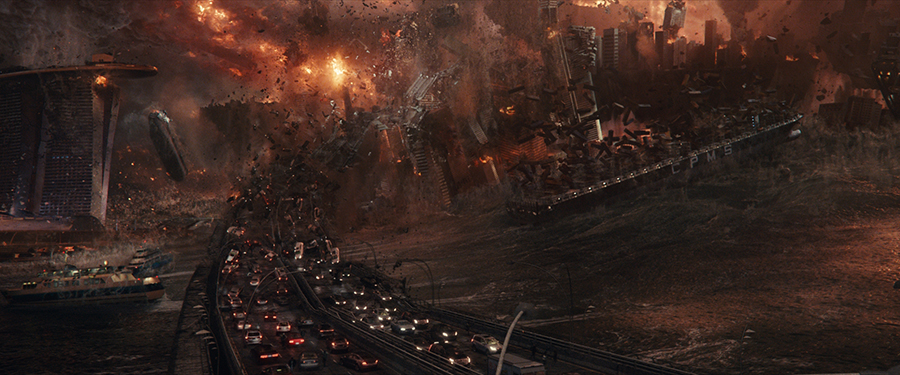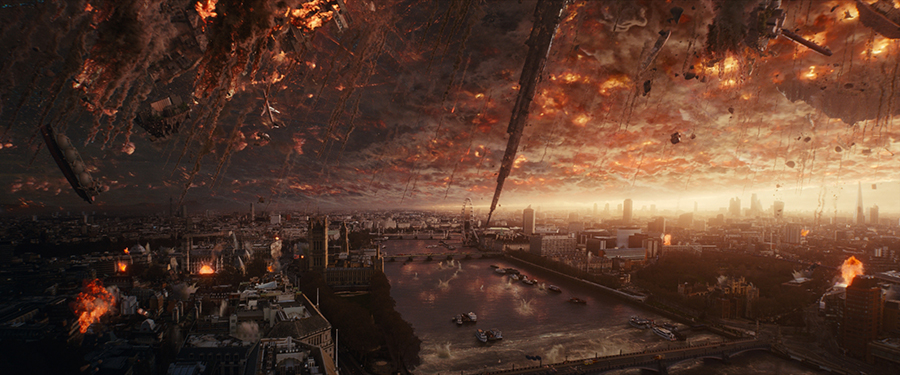
There’s a scene in Independence Day: Resurgencewhere Singapore’s iconic Marina Bay Sands hotel gets blown to bits. Hundreds of cars along the nearby Esplanade Bridge get sucked into the sky. It’s alien Armageddon.
But before extraterrestrials could destroy Singapore, Hollywood had to build its cityscape—a 3D version of it, at least.
To lend an air of authenticity to its urban scenes, Scanline VFX, one of the visual effects companies behind Independence Day: Resurgence and many other blockbusters, hired Matthias Buehler, a specialist in Esri CityEngine.
“In the movie you see the entire Singapore sky burning, and it is impossible to film this—you need visual effects,” said Buehler, who worked as an environment developer lead at Scanline VFX. “A lot [of] the story is told in front of a green screen, and the rest of the environments are computer generated.”
The alien invaders in this sequel to the 1996 hit Independence Day don’t just single out Singapore. The landing of the mothership causes apocalyptic destruction in Washington, DC, and London as well.
Buehler helped build digital 3D replicas of portions of these cities using his extensive experience with Esri’s 3D modeling software. The Swiss native was part of the development team at Procedural, the startup company that created CityEngine. When Procedural was acquired by Esri in 2011, Buehler stayed on as a product engineer focusing on technical support, training materials, and developing CityEngine example content. Recently, he founded his own consulting firm called vrbn, which offers expert CityEngine services in the fields of architecture, urban planning, geodesign, visual effects, and gaming.
“CityEngine is the standard, and more people are getting to know it for large-scale city work,” he said. “There’s no other tool that has these capabilities.”
Buehler, who has a master’s degree in architecture, also has expertise in photorealistic rendering and technical scripting, which was crucial to developing the custom workflows. That is how he began his project for Independence Day: Resurgence.

His goal was to integrate CityEngine into the existing production pipeline so that all departments (modeling, animation, layout, and effects and rendering) could work together. This involved a lot of research, technical scripting, and close collaboration with the visual effects supervisor, Mohsen Mousavi, as well as pipeline developers.
“All the data in CityEngine had to be made available so other artists could work with it in their specific creative tools—to add light, explosions, and render it,” said Buehler. “That was the biggest technical challenge. The whole system also had to be scalable for very large amounts of buildings and large geographic areas.”
Using CityEngine, Buehler designed a sustainable city workflow tailor-made for the needs of Scanline VFX. It allows specifically trained artists to replicate multiple styles of city environments, from rural to urban.
With the system in place, other artists can now learn how to create an environment in a matter of two to three days. Buehler also trained two technical artists to tweak the system so that in the future they will be able to create multiple large-scale environments for alternate designs, and they will be of the same quality as seen in Independence Day: Resurgence.
Buehler worked for nine months on what amounted to approximately 40 seconds of film sequence. Yet the system he put in place can be efficiently reused in any upcoming movie.
He was contractually forbidden to explain to friends and family the work he was doing. Finally, though, when the movie opened in theaters, Buehler was able to wow them with the impressive visual effects.
“I have to say, it was a very proud moment—especially when I saw my name for the first time in the film credits and people around me were clapping,” he said.
For Buehler, it was a moment he had worked toward since childhood. At age 13, he started playing around with 3D graphics as a hobby, using 3D software demo versions from computer magazine CDs.
“I like the freedom of 3D graphics,” he said. “You can create any type of world—worlds that don’t exist, better worlds.”
And even worlds that get destroyed in less than a minute.

